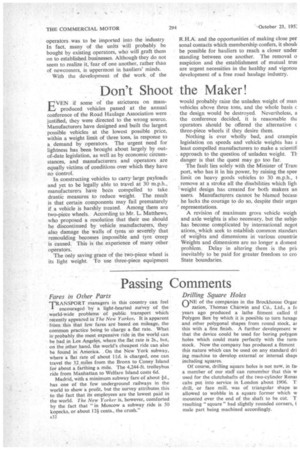Don't Shoot the Maker!
Page 34

If you've noticed an error in this article please click here to report it so we can fix it.
EVEN if some of the strictures on massproduced vehicles passed at the annual conference of the Road Haulage Association were justified, they were directed to the wrong source. Manufacturers have designed and built the largest possible vehicles at the lowest possible price, within a weight limit of three tons, in response to a demand by operators. The urgent need for lightness has been brought about largely by outof-date legislation, as well as by economic circumstances, and manufacturers and operators are equally victims of conditions over which they have no control.
In constructing vehicles to carry 'large payloads and yet to be legally able to travel at 30 m.p.h., manufacturers have been compelled to take drastic measures to reduce weight. The result is that certain components may fail prematurely if a vehicle is harshly treated. Among them are two-piece wheels. According to Mr. L. Matthews, who proposed a resolution that their use should be discontinued by vehicle manufacturers, they also damage the walls of tyres so severely that remoulding becomes impossible and tyre creep is caused. This is the experience of many other operators.
The only saving grace of the two-piece wheel is its light weight. To use three-piece equipment would probably raise the unladen weight of man vehicles above three tons, and the whole basis c the design would be destroyed. Nevertheless, a the conference decided, it is reasonable thE operators should be offered the alternative c three-piece wheels if they desire them.
Nothing is ever wholly bad, and crampin legislation on speeds and vehicle weights has E least compelled manufacturers to make a scientifi approach to the question of unladen weight. it danger is that the quest may go too far.
The fault lies solely with the Minister of Tram port, who has it in his power, by raising the spee limit on heavy goods vehicles to 30 m.p.h., I remove at a stroke all the disabilities which Egli weight design has created for both makers an users. Manufacturers cannot be blamed becau2 he lacks the courage to do so, despite their urger representations.
A revision of maximum gross vehicle weigh and axle weights is also necessary, but the subje has become complicated by international negot ations, which seek to establish common standar( of weights and dimensions in various countrie Weights and dimensions are no longer a domest problem. Delay in altering them is the pri( inevitably to be paid for greater freedom to cro State boundaries.




































































































